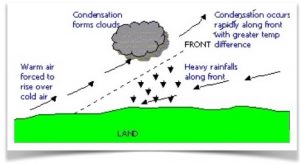 Nature phenomenon on Earth are common things that can be explained scientifically. Existed nature phenomenon on Earth are either harmful or not. All the nature phenomenon can be found around us. Examples of harmless nature phenomenon to humans are the process of rain, the process of a rainbow, the formation of dew and aurora. Meanwhile, nature phenomenon which are harmful to us are known as natural disasters.
Nature phenomenon on Earth are common things that can be explained scientifically. Existed nature phenomenon on Earth are either harmful or not. All the nature phenomenon can be found around us. Examples of harmless nature phenomenon to humans are the process of rain, the process of a rainbow, the formation of dew and aurora. Meanwhile, nature phenomenon which are harmful to us are known as natural disasters.
From all of nature phenomenon existed,the one we frequently know is rain. Rain is part of the water cycle. The water cycle itself is a process of water movement on Earth. And the water cycle is also the reason why water on Earth will never run out even if it’s used continuously. The rain that we often see as rain drops from the sky have various types. These types of rain can be seen in the following. One of them is frontal rain and we will learn more about the process of frontal rain and its description.
Types of Rain
Rain has various types. The types of rain include the following:
- Cyclonal rain
- Orographic rain
- Frontal rain
- Monsoon rains
- Zenithal rain or convection rain
- Acid rain
- Meteor rain
- Artificial rain
Further Reading : 13 Effects of Acid Rain on Ocean That You Should Know
Those are several types of rain. These types of rain have their own process making that may be slightly different from one another. As for this time, we will discuss the process of frontal rain. The following is the explanation.
Frontal Rain Process
Frontal rain is a type of rain that happens because of the confluence between the mass of cold air and low temperatures with the mass of hot air and high temperatures. Frontal rain is commonly happens in areas of astronomical latitude of mid-latitude and southern latitude. There are several stages in the process of frontal rain. the process of frontal rain and its description include the following:
- Existence of mass of cold air and low temperatures
The start point of frontal rain process is marked by a mass of cold air with low air temperatures in a place or area. Masses of cold air with low temperatures usually take place in mountain areas or areas with excessive height, such as plateaus or hills.
- Existence of mass of hot air and high temperatures
In addition, there is also a mass of hot air with high temperatures. Contrary to the initial condition, usually hot air masses with high temperatures are found in lower areas, such as beaches or lowlands. Because there are two different types of air, the area where the frontal rain occurs is called the front or border area.
- The confluence of two different masses and temperatures
This is the stage when two types of air meet. When they meet, low air temperatures and cold air masses are heavier than high air temperatures and hot air masses.
- Water vapor falls to the surface of the earth
The heavier characteristic causes water vapor carried by the mass of cold air and low temperatures to fall to the surface of the earth and conducted frontal rain.
Now those are some stages of the process of frontal rain and its description. The distinctive feature of this rain is that it occurs in the front area, where the area has two different types of air. Hopefully what we learn from this article is useful.